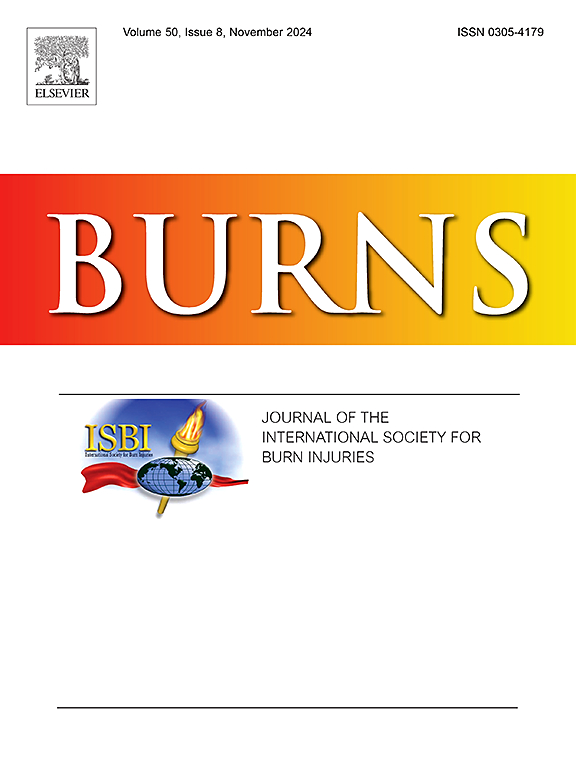High-precision computer-assisted surface area estimation in large surface burn patients using ImageJ – A comparative analysis
IF 3.2
3区 医学
Q2 CRITICAL CARE MEDICINE
引用次数: 0
Abstract
Aims
Several methods for calculating the extent of large surface burns have been described in the literature. However, the commonly used methods have several limitations and an overall tendency to overestimate the burn area. This study aimed to use ImageJ for high-precision computer-assisted estimation of large surface burns.
Methods
A retrospective analysis of the burn registry of the Department of Plastic, Aesthetic, Hand and Reconstructive Surgery of Hannover Medical School was performed from 1st January 2018 to 1st July 2024. Photo documentation of large surface burn patients was used to estimate the total body surface area (TBSA) using ImageJ and compared it to the estimations made by the referring emergency doctor, consultant plastic surgeon and a smartphone application (E-burn 1.0.0).
Results
A total of 37 patients were included in this study. The mean TBSA evaluated by ImageJ was 36.81 %, which was statistically significantly lower than estimations made by a consultant plastic surgeon with 41 % mean TBSA (p = 0.008) and referring emergency doctors with 50.97 % mean TBSA (p < 0.0001). There was no statistically significant correlation between the estimation made by ImageJ and that made by the smartphone application which estimated a mean TBSA of 37.84 % (p = 0.1225).
Conclusions
ImageJ may be used for high-precision computer-assisted volume estimation of large surface burns by counting pixel by pixel to provide highly accurate TBSA estimations.
ImageJ - A在大面积烧伤患者中高精度计算机辅助表面积估算的比较分析
目的几种计算大面积表面烧伤程度的方法已在文献中描述。然而,常用的方法有一些局限性,并且总体倾向于高估烧伤面积。本研究旨在使用ImageJ对大面积表面烧伤进行高精度计算机辅助估计。方法回顾性分析汉诺威医学院整形、美容、手部及重建外科2018年1月1日至2024年7月1日的烧伤病例。使用ImageJ对大面积体表烧伤患者的照片资料进行估计,并将其与转诊急诊医生、整形外科顾问医生和智能手机应用程序(E-burn 1.0.0)的估计进行比较。结果本研究共纳入37例患者。ImageJ评估的TBSA平均值为36.81 %,显著低于会诊整形外科医生的41 % (p = 0.008)和转诊急诊医生的50.97 % (p <; 0.0001)。ImageJ的估计与智能手机应用程序估计的平均TBSA为37.84 % (p = 0.1225)之间没有统计学上的显著相关性。结论simagej可用于大型表面烧伤的高精度计算机辅助体积估计,通过逐像元计数提供高精度的TBSA估计。
本文章由计算机程序翻译,如有差异,请以英文原文为准。
求助全文
约1分钟内获得全文
求助全文
来源期刊

Burns
医学-皮肤病学
CiteScore
4.50
自引率
18.50%
发文量
304
审稿时长
72 days
期刊介绍:
Burns aims to foster the exchange of information among all engaged in preventing and treating the effects of burns. The journal focuses on clinical, scientific and social aspects of these injuries and covers the prevention of the injury, the epidemiology of such injuries and all aspects of treatment including development of new techniques and technologies and verification of existing ones. Regular features include clinical and scientific papers, state of the art reviews and descriptions of burn-care in practice.
Topics covered by Burns include: the effects of smoke on man and animals, their tissues and cells; the responses to and treatment of patients and animals with chemical injuries to the skin; the biological and clinical effects of cold injuries; surgical techniques which are, or may be relevant to the treatment of burned patients during the acute or reconstructive phase following injury; well controlled laboratory studies of the effectiveness of anti-microbial agents on infection and new materials on scarring and healing; inflammatory responses to injury, effectiveness of related agents and other compounds used to modify the physiological and cellular responses to the injury; experimental studies of burns and the outcome of burn wound healing; regenerative medicine concerning the skin.
 求助内容:
求助内容: 应助结果提醒方式:
应助结果提醒方式:


